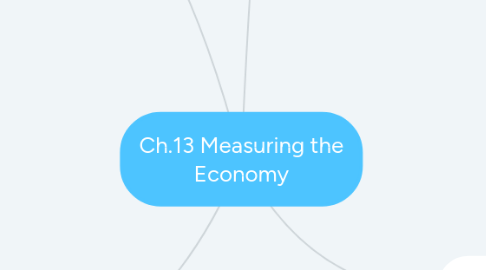Ch.13 Measuring the Economy
von Devin Bush

1. 13.2 How do economists measure the size of an economy?
1.1. The main measure is size of the economy's gross domestic product. *GDP measures an economy's total economic output. Economists use GDP for a lot of things when looking at an economy.
1.2. Economists can tell whether an economy is shrinking or growing by the GDP. They then look to check the inflation of that particular economy.
1.3. Economists also look at an economy's per capital GDP. *Per capital GDP is a nation's real GDP divided by its population. It is exactly what GDP is, but instead of the total economy's output as a whole, it is per person.
1.4. The way that economst calculated GDP, is by separating it into four sectors. The topics that they are separated into are household consumption (C), business investments (I), foreign trade--Net of exports minus imports (NX), and government purchases (G). The formula used to calculate GDP is C+I+G+NX=GDP.
2. 13.3 What Does the Unemployment Rate Tell Us About an Economy’s Health?
2.1. The economy's overall health is poor when the unemployment rate is high. The *unemployment rate is the percentage of working force that is seeking a job, but is not employed.
2.2. A low unemployment rate means that the economy must be pretty well off.
2.3. A couple problems within a society that can cause its health to go down, are the number of discouraged workers throughout the nation. *Discourage workers are unemployed workers who have stopped looking for work. They are not factored into the unemplyment rate. Another problem is that the offical unemployment rate doesn't reconizes involuntary part-time workers. *Involuntary part-time workers are people who can't find full-time jobs, so they settle for part-time jobs.
2.4. The third problem is that there are too many people working undeground or informal economies. The *underground economy conisists of people who get their money from illegal activities such as gambling and drug-dealing.
3. 13.4 What Does the Inflation Rate Reveal About an Economy’s Health?
3.1. The lower the inflation percentage, the healthier the economy is. The *inflation rate is the percentage increase in the average price level of goods and services from one month or year to the next.
3.2. If an economy has a high inflation rate, that would mean that the economy is not healthy.
3.3. Runaway inflation creates extreme uncertainty in an economy. Nobody can predict how high prices will go, and people's confidence in their currency as a store of value begins to decrease.
3.4. Inflation is cuased an increase in an economy's money supply. It also could be caused by either an increase in overall demand, or an increase in the cost of factors of production.
4. 13.5 How Does the Business Cycle Relate to Economic Health?
4.1. The *Business cycle is the reoccurring pattern of growth and decline over time in an economy. The business cycle has four phases.... 1)*Expansion- a period of economic growth 2)*peak- the point at which expansion ends 3)*contraction- economic decline 4(*trough- lowest pint of contraction
4.2. Economists use *leading economic indicators which measure the rise or fall several months before an expansion or contraction begin.
4.3. Business cycles are known as periods of boom and bust. A Boom is the expansion phase.
4.4. The business cycle is full of contractions and expansions, which make the graph look like a snake going up right.


